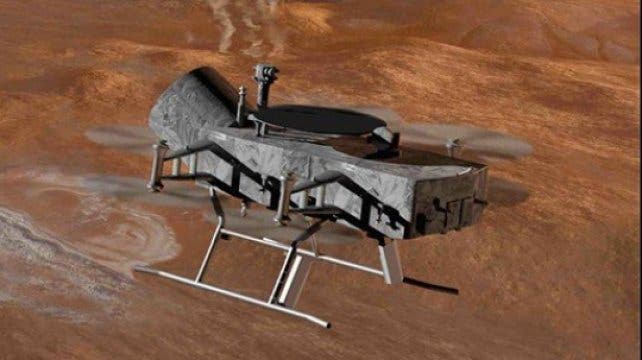A new explorer joins the ranks of proposals for NASA’s New Frontiers initiative. Christened Dragonfly, this nuclear-powered robotic dual-quadcopter will take advantage of Titan’s thick atmosphere and low gravity to hop about the moon and beam back data from potentially habitable sites.

Saturn’s largest moon, Titan, is quite an exciting place for scientists trying to understand how life develops. It has enough water to be comfortably called an ocean world. To be fair it’s frozen solid on the surface, but the interior seems to be a relatively warm, liquid ocean. It also has a diverse chemistry rich in the building blocks biology (as we know it) needs. Put the two together, and what you get is a place with a lot of organic material undergoing the same reactions that we believe went down in Earth’s early days.
All in all, it’s a place that could offer us insight into how life appeared that lab work simply can’t provide. So what NASA wants to do, as part of its New Frontiers exploration program, is to send a pair of eyes to Titan and see what’s what. That pair of eyes, engineers at the Johns Hopkins Applied Physics Laboratory believe, should come in the shape of a dual-quadcopter they named Dragonfly.
“This is the kind of experiment we can’t do in the laboratory because of the time scales involved,” said APL’s Elizabeth Turtle, principal investigator for the Dragonfly mission.
“Mixing of rich, organic molecules and liquid water on the surface of Titan could have persisted over very long timescales. Dragonfly is designed to study the results of Titan’s experiments in prebiotic chemistry.
The drone explorer will carry an array of instruments to any points of interest across the moon’s surface. For this mission, flying sticks out as an ideal method of transportation. Given Titan’s dense atmosphere and low gravity, flying is much easier to do here than on Earth. This means Dragonfly will be able to carry more instruments with the same effort, and flying will let it navigate rugged terrain much faster and with less risk of damage than wheeling about the place.
At every site, the drone will sample atmospheric and surface chemistry with a suite of instruments. This data will allow scientists to estimate the habitability of the moon, see how far Titan’s chemistry has progressed towards biotic chemistry, even pick up eventual traces of water- or hydrocarbon-based life. Mass spectrometry will reveal atmospheric and soil composition, gamma-ray spectrometry will be used to probe into the chemical composition of the shallow sub-surface. A suite of meteorology and geophysics sensors will record wind, pressure, temperature, seismic activity, as well as a host of other factors. Finally, a camera will let scientists peer at the nature of the moon’s surface.
“We could take a lander, put it on Titan, take these four measurements at one place, and significantly increase our understanding of Titan and similar moons,” said Dragonfly project manager Peter Bedini of APL.
“However, we can multiply the value of the mission if we add aerial mobility, which would enable us to access a variety of geologic settings, maximizing the science return and lowering mission risk by going over or around obstacles.”
Later this year, NASA will select a few of the proposals for New Frontiers for further study. Sometime in mid-2019, one will be selected to become the fourth mission in the planetary exploration program.






